| Latest | Greatest | Lobby | Journals | Search | Options | Help | Login |
|
|
|
This topic is archived. |
| Home » Discuss » Topic Forums » Sports |
|
| Jack Rabbit
|
Sun May-11-08 03:22 PM Original message |
| The Jack Rabbit Chess Report (May 11): Chuckie Perfect in Sofia after Four |
|
Ivanchuk perfect after 4 rounds in Sofia
 Vassily Ivanchuk, with four strainght wins, has opened up a point-and-a-half lead over the field after today's fourth round in the fourth annual MTel Masters' Tournament in Sofia, Bulgaria. The Ukrainian grandmaster's victim today was Ivan Cheparinov of Bulgaria, whom "Chuckie" dispatched in 40 moves. In the first three rounds, Ivanchuk defeated Azerbaijani GM Teimour Radjobov, former FIDE world champion Vaselin Topalov of Bulgaria and China's Bu Xiangzhi. In tomorrow's fifth round, he faces Levon Aronian of Armenia. Tomorrow's play will mark the end of the first half of the double-round robin event. Tuesday will be a rest day. Play will resume Wednesday and the tournament concludes a week from today, May 18. US Championships begin Tueday in Tulsa  The 2008 US Championships, sponsored by Oklahoma businessman Frank Berry, begin Tuesday in Tulsa, Oklahoma. The general competition is led by defending champion Alex Shabalov, former champion Alex Onischuk, Foxwoods Open champion Yury Shulman and Greg Kaidanov, winner of this year's Gaudsal Chess Classic in Norway. The format will be a 24-player Swiss system. The women's competition features defending champion Irina Krush and former champion Anna Zantonskih. The format is a round round among ten players. The final round will be played Wednesday, May 21. Play will begin each day at 2:30 pm CDT. Games will be broadcast live on the official tournament website hosted by Monroi.com. |
| Printer Friendly | Permalink | | Top |
| Jack Rabbit
|
Sun May-11-08 03:24 PM Response to Original message |
| 1. Games from Current and Recent Events |
|
More games will be posted later today.
Diagrams on the Jack Rabbit Chess Report are made with Chess M�rida, a true type font that can be downlaoded free here. !""""""""# $tMvWlVmT% $OoOoOoOo% $ + + + +% $+ + + + % $ + + + +% $+ + + + % $pPpPpPpP% $RnBqKbNr% /(((((((() WHITE White to move (This position is a theoretical draw) |
| Printer Friendly | Permalink | | Top |
| Jack Rabbit
|
Sun May-11-08 03:25 PM Response to Reply #1 |
| 2. Topalov - Ivanchuk, Round 2, Sofia |
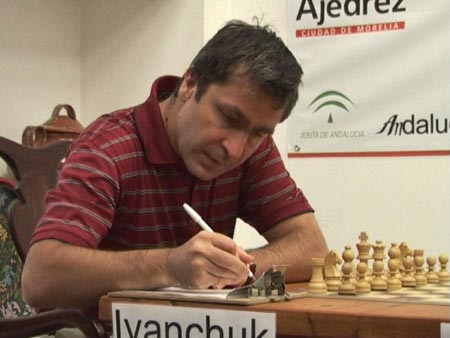 Vassily Ivanchuk Veselin Topalov - Vassily Ivanchuk MTel Masters, Round 2 Sofia, 9 May 2008 Closed French Game: Steinitz Opening 1.e4 e6 2.d4 d5 3.Nc3 Nf6 4.e5 Nfd7 5.f4
5...c5 6.Nf3
6...Nc6 7.Be3 a6
8.a3
8...cxd4 9.Nxd4 Bc5 10.Be2!?
10...0-0 11.Qd2 Qc7 12.Bf3 Nxd4 13.Bxd4 Nb6
14.Ne2 Bxd4 15.Qxd4
15...Bd7
16.b3 Bb5
17.Nc3 Rfc8!?
18.Nxb5!
18...axb5 19.Be2 Nd7 20.Ra2
20...Nb8 21.0-0?
21...Nc6 22.Qd2 !""""""""# $t+T+ +l+% $+oW +oOo% $ +m+o+ +% $+o+oP + % $ + + P +% $Pp+ + + % $r+pQb+pP% $+ + +rK % /(((((((() WHITE: Veselin Topalov Position after 22.Qd4d2 22...Qb6+!
23.Kh1 Qa5
24.Qxa5 Rxa5 25.Raa1 Rca8 26.Rad1
26...Rxa3 27.Bxb5 Nb4 28.c4 R8a5?!
29.f5?!
29...exf5 30.g4
30...Rxb3 31.gxf5 Re3?!
32.Rb1!
32...Nd3 33.e6 d4
34.Be8?
34...Nc5
35.Bxf7+ Kf8 36.f6
36...gxf6 37.Rxf6 Ke7
38.Rh6 !""""""""# $ + + + +% $+o+ Lb+o% $ + +p+ R% $T M + + % $ + O + +% $+ + T + % $ + + + P% $+r+ + +k% /(((((((() WHITE: Veselin Topalov Position after 38.Rf6h6 38...d3!
39.Rxh7
39...d2 40.Rg1 Re1
41.Bh5+ Kxe6 42.Rhg7
42...Ne4 43.R7g6+ Ke5! 0-1
|
| Printer Friendly | Permalink | | Top |
| Jack Rabbit
|
Sun May-11-08 03:27 PM Response to Reply #1 |
| 3. Radjobov - Carlsen, Round 7, Baku |
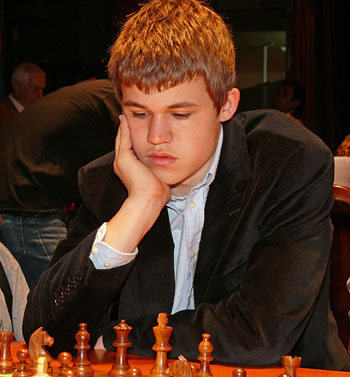 Magnus Carlsen Teimour Radjabov - Magnus Carlsen FIDE Grand Prix, Round 7 Baku, 28 April 2008 Open Sicilian Game: Rat Dragon Defense (Yugoslav Opening) 1.e4 c5 2.Nf3 d6 3.d4 cxd4 4.Nxd4 Nf6 5.Nc3 g6
6.Be3 Bg7 7.f3 Nc6
8.Qd2 0-0 9.Bc4 Bd7
10.Bb3 Rc8
11.h4 h5 12.0-0-0 Ne5 13.Bg5
13...Rc5 14.Kb1
14...Re8
15.g4
15...hxg4 16.h5
16...Nxh5 17.Rxh5?
17...gxh5 18.Qh2 Ng6?
19.Qxh5 Qa5 20.f4 Rxg5!?
21.fxg5!
21...e6 22.Nf5?
22...exf5 23.Qxg6 !""""""""# $ + +t+l+% $Oo+v+oV % $ + O +q+% $W + +oP % $ + +p+o+% $+bN + + % $pPp+ + +% $+k+r+ + % /(((((((() WHITE: Teimour Radjobov Position after 23.Qh5g6:N 23...Be6!
24.Qh5 fxe4 25.Rf1 Qe5 26.Rxf7
26...Bxb3 27.axb3 g3 28.Ka2
28...Rf8 29.Rxf8+ Kxf8 30.Qg4
!""""""""# $ + + L +% $Oo+ + V % $ + O + +% $+ + W P % $ + +o+q+% $+pN + O % $kPp+ + +% $+ + + + % /(((((((() WHITE: Teimour Radjobov Position after 30.Qh5g4 30...e3!
31.g6 e2?
32.Qf3+?
32...Ke8
33.Qf7+ Kd8 34.Qg8+ Kd7 35.Qf7+ Qe7 36.Qf5+
36...Kd8 37.Qa5+ b6!
38.Qd5 e1Q 39.Qa8+ Kd7 40.Qb7+ Ke8 0-1
|
| Printer Friendly | Permalink | | Top |
| Jack Rabbit
|
Sun May-11-08 06:38 PM Response to Reply #1 |
| 4. Gashimov - Grischuk, Round 12, Baku |
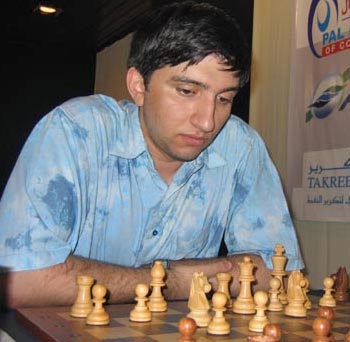 Vugar Gashimov Vugar Gashimov - Alexander Grischuk FIDE Grand Prix, Round 12 Baku, 4 May 2008 Spanish Grand Royal Game: Rat Defense (Neo-Steinitz Defense) 1.e4 e5 2.Nf3 Nc6 3.Bb5 a6 4.Ba4 d6
5.0-0
5...Bg4 6.h3 h5
7.d4
7...b5 8.Bb3 Nxd4!?
9.hxg4 Nxb3
10.axb3 hxg4 11.Ng5 Qd7 12.Qd3!?
12...Rb8?!
13.Rxa6 f6 14.Nc3 fxg5 15.Bxg5 Be7
16.f4 gxf3 17.Qxf3 Nf6
18.Nd5 Nxd5
19.Qf7+ Kd8 20.Qxg7 Kc8
21.Qxh8+ Kb7 22.Qh7 Qg4
23.exd5 Qd4+ 24.Kh1 Bxg5 25.Rfa1 Be3
!""""""""# $ T + + +% $+lO + +q% $r+ O + +% $+o+pO + % $ + W + +% $+p+ V + % $ Pp+ +p+% $R + + +k% /(((((((() WHITE: Vugar Gashimov Position after 25...Bg5e3 26.Ra7+!
pb<26...Qxa7 27.Rxa7+ Bxa7 28.g4 Rf8 29.g5 Rf2 [/b>
30.Qe4 Rf1+ 31.Kh2 Rf4 !""""""""# $ + + + +% $VlO + + % $ + O + +% $+o+pO P % $ + +qT +% $+p+ + + % $ Pp+ + K% $+ + + + % /(((((((() WHITE: Vugar Gashimov Position after 31...Rf1f4 32.Qxf4!!
32...exf4 33.c3 1-0
|
| Printer Friendly | Permalink | | Top |
| Jack Rabbit
|
Sun May-11-08 06:39 PM Response to Reply #1 |
| 5. Grischuk - Inarkiev, Round 9, Baku |
 Alexander Grischuk Alexander Grischuk - Ernesto Inarkiev FIDE Grand Prix. Round 9 Baku, 30 April 2008 West India Game: King's Indian Defense (Karlsbad Opening) 1.d4 Nf6 2.c4 g6 3.g3 Bg7 4.Bg2
4...0-0 5.Nc3 d6 6.Nf3 Nc6
7.0-0
7...Rb8
8.h3 e5
9.Be3
9...a6
10.Rc1 Bf5!?
11.g4
11...Bd7
12.Qd2 h5
13.dxe5 dxe5 14.g5 Nh7 15.Rfd1
15...Bf5 16.Qxd8 Rfxd8
17.h4 Be6 18.Rxd8+ Rxd8 19.Nd5 Rd7
20.Nd2 Nd4 21.Bxd4 exd4 22.Nf4
22...c6 23.Nxe6 fxe6 24.Be4
24...Nf8 25.Nb3!?
25...Rf7 26.Kg2
26...d3?
27.Bxd3 Bxb2 28.Rb1 Bc3 !""""""""# $ + + Ml+% $+o+ +t+ % $o+o+o+o+% $+ + + Pp% $ +p+ + P% $+nVb+ + % $o+ +pPk+% $+r+ + + % /(((((((() WHITE: Alexander Grischuk Position after 28...Bb2c3 29.Nc5!
29...Bd4
30.Ne4 Rc7
31.e3 Ba7 32.c5 Nd7
33.Rc1
33...Kh7
34.f4 Rc8 35.Rc3
35...Rf8 36.Rb3 Rb8 37.Rc3
37...Rf8 38.Bc2 e5 39.Rb3!
39...Nxc5 40.Nxc5 Bxc5 41.Rxb7+ Kh8 42.f5 Rd8 43.Bb3 Rd6
!""""""""# $ + + + L% $+r+ + + % $o+oT +o+% $+ V OpPo% $ + + + P% $+b+ P + % $o+ + +k+% $+ + + + % /(((((((() WHITE: Alexander Grischuk Position after 43...Rd8d6 44.f6!!
44...e4 45.Rg7 Rd2+ 46.Kf1 1-0
|
| Printer Friendly | Permalink | | Top |
| Jack Rabbit
|
Mon May-12-08 12:15 AM Response to Reply #1 |
| 6. Movsesian - Grigoriants, General Round 5. Plovdiv |
|
Sergei Movsesian led or had a share of the lead though most of the tournament in Plovdiv, only to be overtaken, along with every one else, by Sergei Tiviakov in the final round.
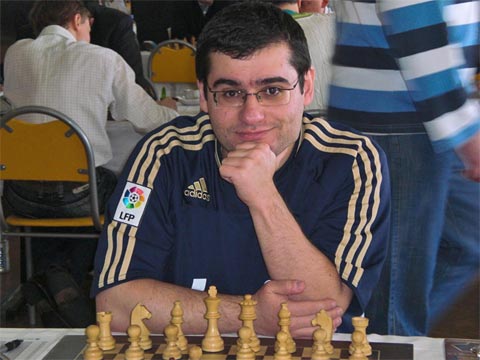 Sergei Movsesian Sergei Movsesian - Sergey Grigoriants European Championships (General Competition), Round 5 Plovdiv, 25 April 2008 Closed German Game: Short Opening 1.e4 c6 2.d4 d5 3.e5 Bf5 4.Nf3 e6 5.Be2 Nd7
6.0-0 h6
7.Nbd2 Ne7 8.Nb3 g5
9.Bd2!?
9...Bg7
10.Na5
10...Rb8
11.c4 b6 12.Nb3 0-0
13.Rc1 dxc4 14.Rxc4
14...Be4 15.h4 g4 16.Ne1 Bd5
17.Rc3 c5 18.Bxg4
18...cxd4 19.Rg3 Nxe5?!
20.Bh3 N7g6
21.h5 f5 22.Nxd4 Bc4?
!""""""""# $ T W Tl+% $O + + V % $ O +o+mO% $+ + Mo+p% $ +vN + +% $+ + + Rb% $pP B Pp+% $+ +qNrK % /(((((((() WHITE: Sergei Movsesian Position after 22...Bd5c4 23.Nec2!!
23...Bxf1 24.Kxf1 Qh4 25.hxg6
25...Rbd8 26.Bc3 Nc6 27.Rd3 Ne5
28.Rd2 Nc4 29.Re2 e5
!""""""""# $ + T Tl+% $O + + V % $ O + +pO% $+ + Oo+ % $ +mN + +% $+ B + + % $pPn+rPp+% $+ +q+k+ % /(((((((() WHITE: Sergei Movsesian Position after 29...e6e5 30.Qd3!
30...exd4 31.Qxc4+ Kh8 32.Bb4 Rfe8 33.Rxe8+ Rxe8 34.Qd3
34...f4 35.Ne1 Qh5 36.Nf3 Qd5 37.b3 a5
38.Bd2 Rf8 39.Kg1 a4 40.bxa4 Qxa2 41.Qb5 Qc2
42.Qxb6 Qxa4 43.Qd6 Qe8 44.Bxf4 Rf6 45.Qxd4 Qxg6 46.Qe3
46...Rf8 47.Be5 Re8 48.Bxg7+ Kxg7 49.Ne5 1-0
|
| Printer Friendly | Permalink | | Top |
| Jack Rabbit
|
Mon May-12-08 12:17 AM Response to Reply #1 |
| 7. Sebag - Kokarev, General Round 10, Plovdiv |
|
Marie Sebag of France, the only woman competing in the general competition in Plovdiv, achieved her goal: her third GM norm, qualifying her to be a full grandmaster.
 International Grandmaster Marie Sebag Marie Sebag - Dmitri Kokarev European Championships (General Competition), Round 10 Plovdiv, 1 May 2008 Open Sicilian Game: Najdorf Scheveningen Defense (Rauzer Opening 1.e4 c5 2.Nf3 d6 3.d4 cxd4 4.Nxd4 Nf6 5.Nc3 a6 6.Bg5
6...e6 7.f4 h6
8.Bh4 Be7 9.Qf3 Qc7 10.0-0-0 Nbd7 11.Be2
11...b5 12.Bxf6
12...Nxf6 13.e5 Bb7 14.Qg3 dxe5 15.fxe5 Nd5?!
16.Nxe6 fxe6 17.Qg6+ Kd7 18.Bg4 Qxe5 19.Nxd5 Bxd5?
!""""""""# $t+ + + T% $+ +lV O % $o+ +o+qO% $+o+bW + % $ + + +b+% $+ + + + % $pPp+ +pP% $+ Kr+ +r% /(((((((() WHITE: Marie Sebag Position after 19...Bb7d5:N 20.Rxd5+!!
20...Qxd5 21.Rd1 Bg5+ 22.Kb1 Qxd1+ 23.Bxd1 Bf6
24.Qf7+
24...Kd6 25.Bf3 Rab8 26.Qa7 b4
27.Qxa6+ Ke7 28.Qa7+ Kd6 29.a3 bxa3 30.Qxa3+ Kd7 31.c3 Rhc8 32.Qa7+ Kd6 33.Kc2 Re8
34.Bb7 Red8 35.b4 Ke7 36.Bc8+ 1-0
|
| Printer Friendly | Permalink | | Top |
| Jack Rabbit
|
Mon May-12-08 02:11 AM Response to Reply #1 |
| 8. Mkrtchian - Golubenko, Ladies' Round 1, Plovdiv |
 Lilit Mkrtchian Lilit Mkrtchian - Valentina Golubenko European Championships (Ladies' Competition), Round 1 Plovdiv, 21 April 2008 Spanish Petit Royal Game: Calabrian Defense (Schliemann Defense) 1.e4 e5 2.Nf3 Nc6 3.Bb5 f5!?
4.d3
4...fxe4 5.dxe4 Nf6 6.0-0 Bc5
7.Bxc6
7...bxc6 8.Nxe5 0-0 9.Bg5
9...Qe8 10.Bxf6 Rxf6 11.Nd3 Bb6
12.Nd2 Ba6 13.c4 d5 14.e5 Re6!?
15.Qa4
15...dxc4 16.Nxc4
16...Bb5 17.Qb3 Kh8 18.Nxb6 cxb6
19.f4!
19...c5 20.Qc3 Rd8 21.Rf3
21...c4 22.Nf2 Bc6 23.Rg3 b5 24.Re1 Qf8 25.Qe3
25...a6 26.Ne4 Ree8?
27.Nc5!
27...a5 28.Qf2 Rd5 29.Ne4 Qe7
30.Rh3 Bd7 31.Rhe3 Rf8
!""""""""# $ + + T L% $+ +vB Oo% $ + + + +% $Oo+tP + % $ +o+nP +% $+ + R + % $pP + QpP% $+ + R K % /(((((((() WHITE: Lilit Mkrtchian Position after 31...Re8f8 32.Nd6!
32...Bf5 33.Qf3 Rd2
34.R3e2 Rxe2 35.Qxe2
35...Bd3 36.Qe3 Qd7
37.Qd4 b4
38.e6 Qe7 39.Re3
39...Kg8 40.Nxc4 Rd8
!""""""""# $ + T +l+% $+ + W Oo% $ + +p+ +% $O + + + % $ OnQ P +% $+ +vR + % $Pp + +pP% $+ + + K % /(((((((() WHITE: Lilit Mkrtchian Position after 40...Rf8d8 41.Qxd8+!!
41...Qxd8 42.e7 Qxe7
43.Rxe7 Bxc4 44.b3 1-0
|
| Printer Friendly | Permalink | | Top |
| Jack Rabbit
|
Mon May-12-08 02:13 AM Response to Reply #1 |
| 9. Voiska - Cramling, Ladies' Round 4, Plovdiv |
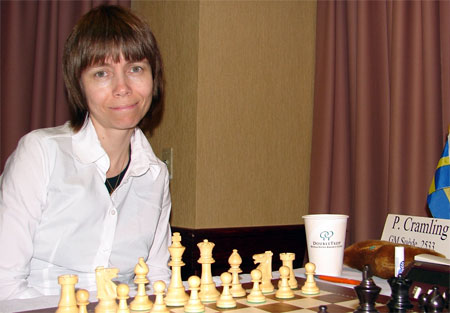 Pia Cramling Margarita Voiska - Pia Cramling European Championships (Ladies' Competition), Round 4 Plovdiv, 24 April 2008 Indian Knights Game: Polish Defense 1.d4 Nf6 2.Nf3 e6 3.g3 d5 4.Bg2 b5
5.0-0 Nbd7
6.Bg5!?
6...Be7 7.Qd3
7...a6 8.Nbd2 Bb7 9.Nb3
9...c5 10.Nxc5 Nxc5 11.dxc5 Bxc5
12.Nd4 0-0 13.c3
13...h6
14.Bxf6 Qxf6 15.Nb3 Bb6 16.a4
16...Bc6 17.a5
17...Ba7 18.Nd4 Bb7 19.e3 Rac8 20.Rfd1 Rc4 21.Nc2
21...Rd8 22.Qe2
22...g6
23.Rd2 Kg7
24.Na3 Rcc8
25.Nc2 Bb8 26.Rad1 Bc7!?
27.e4?
!""""""""# $ +tT + +% $+vV +oL % $o+ +oWoO% $Po+o+ + % $ + +p+ +% $+ P + P % $ PnRqPbP% $+ +r+ K % /(((((((() WHITE: Margarita Voiska Position after 27.e3e4 27...dxe4!!
28.Bxe4 Qe5
29.Bf3
29...Qxe2 30.Bxe2 Bxa5 31.Rxd8 Rxd8 32.Rxd8 Bxd8
33.c4 Be4
34.Ne3 b4
35.f3
35...Bc6 36.Nc2
36...a5!
37.Kf2
37...Bb6+ 38.Kf1 b3
39.Ne1 Bd4 40.Nd3 a4
41.Bd1 Bb7 42.c5 Ba6 43.Be2
!""""""""# $ + + + +% $+ + +oL % $v+ +o+oO% $+ P + + % $o+ V + +% $+o+n+pP % $ P +b+ P% $+ + +k+ % /(((((((() WHITE: Margarita Voiska Position after 43.Bd1e2 43...Bxb2!! 44.Nxb2 a3 0-1
|
| Printer Friendly | Permalink | | Top |
| Jack Rabbit
|
Mon May-12-08 12:08 PM Response to Original message |
| 10. Update (Monday): Ivanchuk completes first robin with perfect score |
|
Ukrainian GM Vassily Ivanchuk, playing Black, defeated Levon Aronian of Armenia in 40 moves today for his fifth win in as many games as the first half of the fourth annual MTel Masters' Tournament completed in the Bulgarian capital of Sofia.
Also winning toady was former FIDE world champion Veselin Topalov of Bulgaria, who is in second place with 3� points. The rest of the field is being left in the dust. Tomorrow is a rest day for the players. The second half of the double round robin tournament begins Wednesday. Grandmaster Ivanchuk scored three of his five victories in the first half of the event with Black. He will have White three times in the remaining five rounds. |
| Printer Friendly | Permalink | | Top |
| DU
AdBot (1000+ posts) |
Thu Apr 25th 2024, 05:25 AM Response to Original message |
| Advertisements [?] |
| Top |
| Home » Discuss » Topic Forums » Sports |
|
Powered by DCForum+ Version 1.1 Copyright 1997-2002 DCScripts.com
Software has been extensively modified by the DU administrators
Important Notices: By participating on this discussion board, visitors agree to abide by the rules outlined on our Rules page. Messages posted on the Democratic Underground Discussion Forums are the opinions of the individuals who post them, and do not necessarily represent the opinions of Democratic Underground, LLC.
Home | Discussion Forums | Journals | Store | Donate
About DU | Contact Us | Privacy Policy
Got a message for Democratic Underground? Click here to send us a message.
© 2001 - 2011 Democratic Underground, LLC